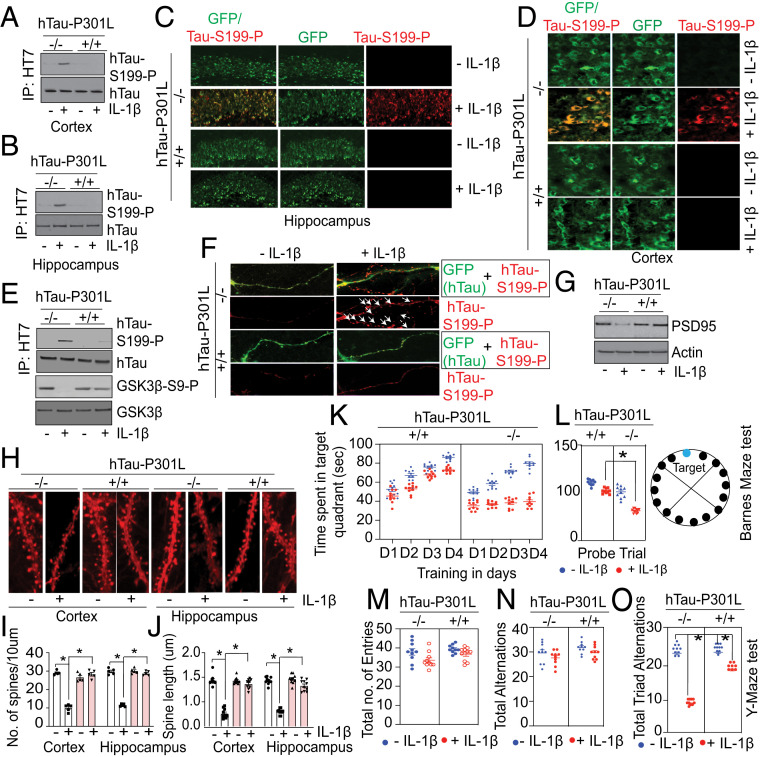Fig. 5.
In AKT-KI+/+ mice, the synaptic integrity and cognitive dysfunction were restored compared to AKT-KI−/− mice after administration of IL-1β. (A and B) Compared to AKT-KI−/− mice, the induction of hTau-S199 phosphorylation was restored in the cortex (A) and hippocampus (B) of AKT-KI+/+ mice overexpressing hTau-P301L, after administration of IL-1β (10 ng) in the cortex. (C and D) The confocal analysis shows that the hTau-S199 phosphorylation was decreased in the hippocampus (C) and cortex (D) of AKT-KI+/+ compared to AKT-KI−/− mice overexpressing hTau-P301L after administration of IL-1β. (E) Compared to AKT-KI−/− neurons, the induction of hTau-S199 phosphorylation was restored in AKT-KI+/+ neurons overexpressed with hTau-P301L, after administration of IL-1β (10 ng). (F) Confocal microscopic studies show that the level of hTau-S199 phosphorylation in spines was reduced in AKT-KI+/+ neurons overexpressed with hTau-P301L after administration of IL-1β (10 ng). (G) Western blot analysis shows that PSD95 was decreased in AKT-KI−/− mice but rescued in AKT-KI+/+ mice overexpressing hTau-P301L after administration of IL-1β. (H) Confocal microscopic analysis shows that the loss of synaptic puncta as shown by DiI staining in the cortex and hippocampus was rescued in AKT-KI+/+ mice overexpressing hTau-P301L after administration of IL-1β. (I and J) The loss in the number of spines per 10 μm of dendrites (I) and loss in spine length (μm) of dendrites (J), were rescued in the cortex and hippocampus of AKT-KI+/+ mice compared to AKT-KI−/− mice after administration of IL1β. (K and L) the time spent in the target quadrant was improved IL-1β–treated AKT-KI+/+ mice overexpressing hTau-P301L compared to AKT-KI−/− mice overexpressing hTau-P301L during 4 d of training (K) and the day of probe trial (L) in the Barnes maze test. A representative image of The Barnes maze was presented where the target hole was colored as blue while the other holes are shown in black color. (M–O) The total number of entries (M), total alternations (N), and the total number of triad alternations (O) were determined in the Y-maze test. The total number of entries, alternations were unaltered among AKT-KI+/+ mice or AKT-KI−/− mice overexpressing hTau-P301L treated with or without IL-1β. However, the total number of triad alternations was rescued in IL-1β–treated AKT-KI+/+ mice overexpressing hTau-P301L compared to IL-1β–treated AKT-KI−/− mice overexpressing hTau-P301L. One-way ANOVA measured statistical significance with a Tukey–Kramer post hoc correction, n = 10, *P < 0.05. All data are expressed as mean ± SEM. The arrowheads in F indicate the dendritic spines. (Magnification: C, 20×; D, 40; F and H, 60×.)

